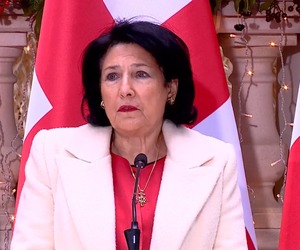ყვავილები, რომლებისგანაც Chanel No. 5 მზადდება
In late spring, the bees arrive at Joseph Mul’s fields near Pégomas, France, at around nine-thirty each morning. The unmarked fifty acres border a gravel path, which veers off a country road that cuts through a sheltered valley. To the northeast, one can make out the dark-blue mounds of the pre-Alps. A tickly breeze blows in from the Mediterranean, a few miles to the east. For non-pollinators, the site is almost impossible to find. This is intentional, as, since the mid-nineteen-eighties, the Mul family has had an exclusive partnership to grow jasmine and roses for Chanel. The company uses the flowers to make Chanel No. 5—a perfume that, in the way of a Cavaillon melon or a piece of Sèvres porcelain, comes from a specific place.
The roses are Rosa centifolia: “hundred petal” roses, or cabbage roses, their frilly, dishevelled flowers often bowing under their own weight.
The species is prized for its clear, sweet, honeyed scent. If it were a musical instrument, it might be a flute. It is so distinctive that Joseph Mul, whose great-grandfather started the farm in the early nineteen-hundreds, can identify a rose grown in Pégomas with his eyes closed. “You can compare it to wine,” he said recently. “A Burgundy from anywhere else isn’t a Burgundy.”
One early morning last May, Mul was standing in the middle of his pink rows, their fragrance intensifying as the sun ascended. Grabbing a blossom by the calyx, he demonstrated the proper way to cull a rose. “One finger over, one finger under,” he said. “Then twist! You can hear the snap.”
When the roses bloom, the entire fifty acres must be harvested in two weeks. Mul works with his son-in-law, Fabrice Bianchi, to supervise a crew that comprises seventy pickers (mainly Turkish women, many of them related) and four videurs(mainly French men, into whose burlap sacks the women empty their aprons). They were expecting to haul in thirty-seven tons of flowers.
The pickers worked in pairs and gossiped as they gleaned. Songul Ozer, singing to herself, said that she preferred the work to her old job, as a secretary. It was her fifth season in the Mul fields. The symmetry of the women’s movements and their pale, wide-brimmed hats gave the scene the look of a Bruegel painting.
Once the roses have been harvested, their oils must be extracted quickly, before they start to ferment. “Put one in your fist,” Mul said, wrapping his weathered brown hand around mine. “Even after two or three minutes, it’s not going to have the same smell.” He was right: the rose had become slightly more peppery. Three to five hundred roses make a kilo. The videurs filled sacks of ten kilos apiece and loaded them onto a flatbed truck. Within the hour, they were delivered to an on-site factory.
“We have a phrase, ‘la fleur au flacon’—the flower into the bottle,” Olivier Polge, Chanel’s head perfumer, or “nose,” said, explaining how the setup presents a competitive advantage. “I’m able to work like a painter with his special colors,” he said. “It’s our own Pantone of perfume.” Polge, who is the fourth nose in Chanel’s history, took over the job from his father. Mul’s cousin Jean-François Vieille oversees the factory. As he explained how blossoms become smells—aided by a pedagogical poster tracing the process from raw material (petals) to concrete (a waxy solid) to absolute (a highly concentrated oil that goes directly into many perfumes)—workers dumped sack after sack of roses into a giant metal vat, as though they were offloading loot in a heist film.
This was the concrete-making phase. A worker used a pitchfork to even out the piles as Vieille pumped in two thousand litres of hexane, a colorless liquid solvent, heated it to sixty-eight degrees Celsius, and then reopened the vat. The flowers had gone from pink to brown. The air smelled of burned toast. The factory floor looked like a wedding processional had just passed through.
There were more steps, but, in the end, each thirty-millilitre bottle of Chanel No. 5 represents the afterlife of a thousand Pégomas jasmine flowers and twelve Pégomas roses. “A living material gives you an identity that no synthetic can give,” Polge said. “People think of perfume as something elusive, but I really like this feet-in-the-mud side to it.”
-
პრეზიდენტი: დღეს დავადე ვეტო რუსულ კანონს პრეზიდენტი: დღეს დავადე ვეტო რუსულ კანონს
 გადახედვა
გადახედვა
-
გურამ იმნაძე: როგორ მოვიქცეთ, თუ საგამოძიებო უწყებაში დაგვიბარებენ გურამ იმნაძე: როგორ მოვიქცეთ, თუ საგამოძიებო უწყებაში დაგვიბარებენ
 გადახედვა
გადახედვა
-
ქურდოვანიძე: თუ აქამდე კანონში მხოლოდ მედია და არასამთავრობოები იყო მოხსენიებული, ახლა მოიცვა ნებისმიერი შპს, ინდ. მეწარმე, და აბსოლუტურად ყველა ქურდოვანიძე: თუ აქამდე კანონში მხოლოდ მედია და არასამთავრობოები იყო მოხსენიებული, ახლა მოიცვა ნებისმიერი შპს, ინდ. მეწარმე, და აბსოლუტურად ყველა
 გადახედვა
გადახედვა
-
კობახიძის ლექციის პარალელურად, თსუ-ს მეორე კორპუსთან სტუდენტებს სცემეს კობახიძის ლექციის პარალელურად, თსუ-ს მეორე კორპუსთან სტუდენტებს სცემეს
 გადახედვა
გადახედვა
-
საფრანგეთი აზერბაიჯანს ახალ კალედონიაში არეულობების მხარდაჭერაში ადანაშაულებს საფრანგეთი აზერბაიჯანს ახალ კალედონიაში არეულობების მხარდაჭერაში ადანაშაულებს
 გადახედვა
გადახედვა
-
ვახუშტი მენაბდე: ამ კანონით, შეიძლება მოგთხოვონ ნებისმიერი "საჭირო ინფორმაცია“ არა მარტო თქვენზე, არამედ სხვაზეც ვახუშტი მენაბდე: ამ კანონით, შეიძლება მოგთხოვონ ნებისმიერი "საჭირო ინფორმაცია“ არა მარტო თქვენზე, არამედ სხვაზეც
 გადახედვა
გადახედვა
-
აღმოაჩინეს ჰორმონი, რომელიც მონოგამიასთან არის დაკავშირებული აღმოაჩინეს ჰორმონი, რომელიც მონოგამიასთან არის დაკავშირებული
 გადახედვა
გადახედვა
-
მილიარდერობა უფრო მეტ ჭკუაზე ხშირად არ მიუთითებს — აი, რატომ მილიარდერობა უფრო მეტ ჭკუაზე ხშირად არ მიუთითებს — აი, რატომ
 გადახედვა
გადახედვა
-
ფოტორეპორტაჟი: როგორ აღნიშნეს თბილისში "ოჯახის სიწმინდის დღე" ფოტორეპორტაჟი: როგორ აღნიშნეს თბილისში "ოჯახის სიწმინდის დღე"
 გადახედვა
გადახედვა
-
ჯაფარიძე: პოლიცია მასობრივად იბარებს ხალხს, "აქციებთან დაკავშირებით" დამიბარეს მეც გამოკითხვაზე ჯაფარიძე: პოლიცია მასობრივად იბარებს ხალხს, "აქციებთან დაკავშირებით" დამიბარეს მეც გამოკითხვაზე
 გადახედვა
გადახედვა
-
პირამიდებთან ახლოს ნილოსის ძველი განშტოების კვალს მიაგნეს პირამიდებთან ახლოს ნილოსის ძველი განშტოების კვალს მიაგნეს
 გადახედვა
გადახედვა
-
გენური თერაპიის მეშვეობით ბავშვს სმენა აღუდგინეს გენური თერაპიის მეშვეობით ბავშვს სმენა აღუდგინეს
 გადახედვა
გადახედვა
-
ქვიზი: გამოიცანი ცნობილი ფილმი დაპიქსელებული კადრით ქვიზი: გამოიცანი ცნობილი ფილმი დაპიქსელებული კადრით

-
ქვიზი: გამოიცანი ცნობილი რეჟისორი ფილმით ქვიზი: გამოიცანი ცნობილი რეჟისორი ფილმით

-
ვარჯიში დროის აღქმას ცვლის — კვლევა ვარჯიში დროის აღქმას ცვლის — კვლევა
 გადახედვა
გადახედვა
-
კადიროვის "მარჯვენა ხელმა", დაუდოვმა, მოულოდნელად პარლამენტის თავმჯდომარის თანამდებობა დატოვა კადიროვის "მარჯვენა ხელმა", დაუდოვმა, მოულოდნელად პარლამენტის თავმჯდომარის თანამდებობა დატოვა
 გადახედვა
გადახედვა
-
მიტროპოლიტი შიო: კანონის როგორც მომხრეთა, ისე მოწინააღმდეგეთა შორის არიან ეკლესიის წევრები, ჩვენი სულიერი შვილები. ვფიქრობთ, როგორ დაიძლიოს ეს დაპირისპირება მიტროპოლიტი შიო: კანონის როგორც მომხრეთა, ისე მოწინააღმდეგეთა შორის არიან ეკლესიის წევრები, ჩვენი სულიერი შვილები. ვფიქრობთ, როგორ დაიძლიოს ეს დაპირისპირება
 გადახედვა
გადახედვა
-
ქეთი მელუა: 21 წლის ასაკში ქალთან მქონდა ურთიერთობა, დიდ პატივს ვცემ ანტი-ჰომოფობიის დღეს ქეთი მელუა: 21 წლის ასაკში ქალთან მქონდა ურთიერთობა, დიდ პატივს ვცემ ანტი-ჰომოფობიის დღეს
 გადახედვა
გადახედვა
-
ნახეთ: იუპიტერის ყინულოვანი თანამგზავრი ევროპა NASA-ს ზონდის ობიექტივში ნახეთ: იუპიტერის ყინულოვანი თანამგზავრი ევროპა NASA-ს ზონდის ობიექტივში
 გადახედვა
გადახედვა
-
იურისტი საბა ბრაჭველი: ხელისუფლებამ კანონში ჩუმად ჩაამატა ცვლილებები, რომლითაც მისი მოქმედება ფიზიკურ პირებზეც გავრცელდება იურისტი საბა ბრაჭველი: ხელისუფლებამ კანონში ჩუმად ჩაამატა ცვლილებები, რომლითაც მისი მოქმედება ფიზიკურ პირებზეც გავრცელდება
 გადახედვა
გადახედვა
-
ღაზაში შევიდა პირველადი დახმარების ტვირთი, ამერიკის მიერ აშენებული დროებითი ნავსადგურის საშუალებით ღაზაში შევიდა პირველადი დახმარების ტვირთი, ამერიკის მიერ აშენებული დროებითი ნავსადგურის საშუალებით
 გადახედვა
გადახედვა

 საჩუქრები
საჩუქრები







































